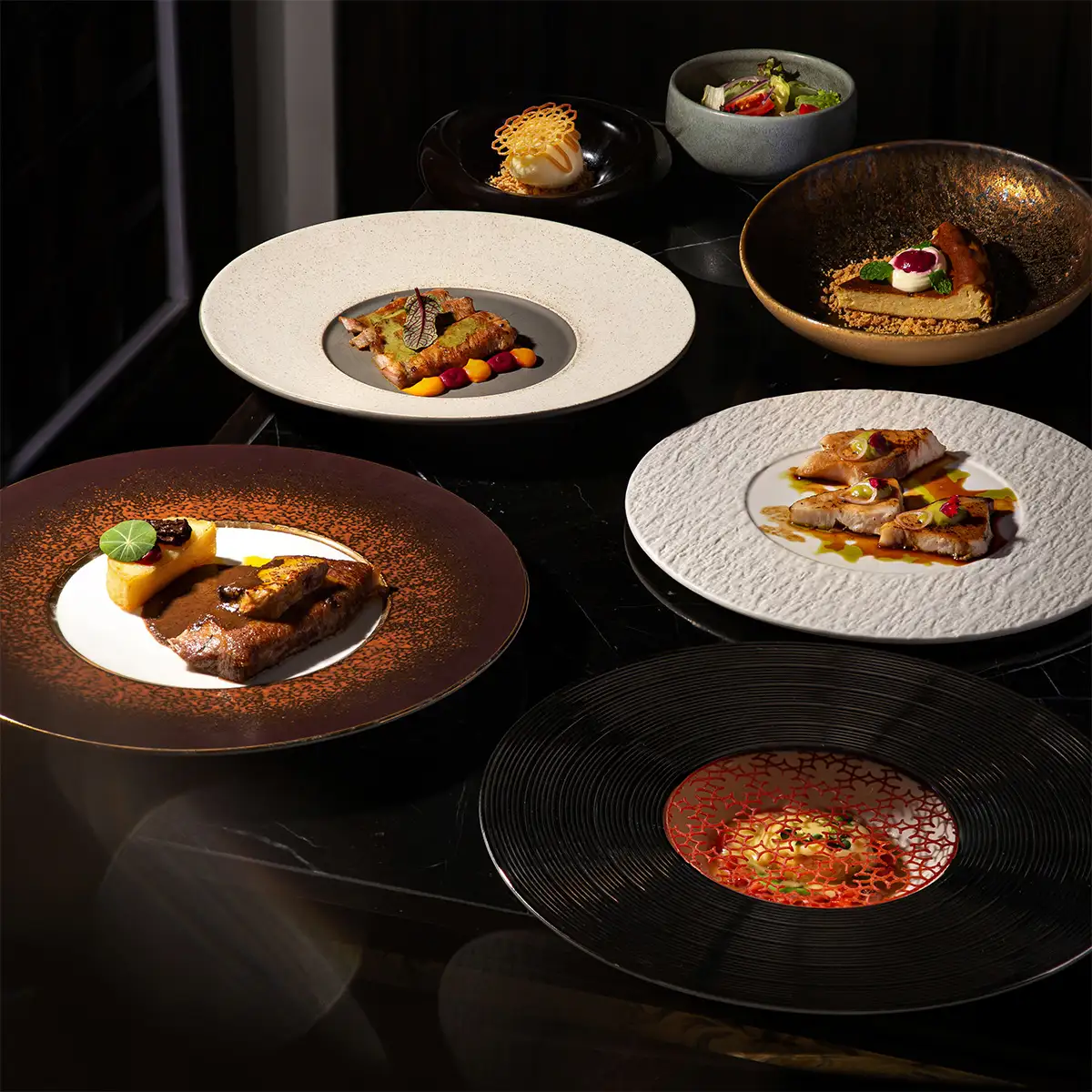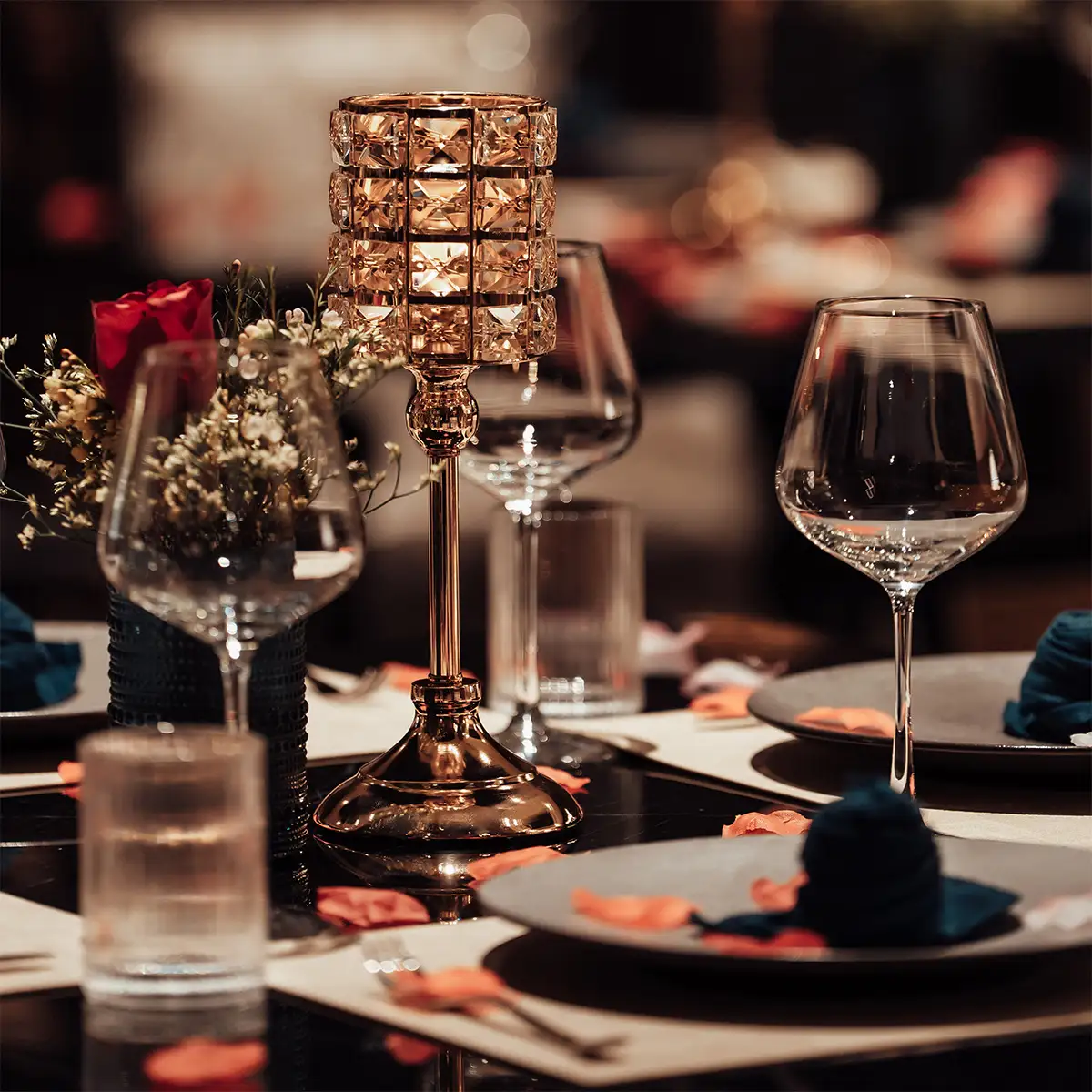In the realm of haute cuisine, the experience transcends the mere act of eating; it is a carefully orchestrated symphony of sensations, and the fine dining table setting is its overture. Long before the first exquisite dish arrives, the table itself communicates a message of care, precision, and anticipation. But what exactly constitutes a "fine dining table setting," and why does it hold such profound importance in the architecture of an exceptional meal? This article aims to explore the intricate concept of the fine dining table setting, share knowledge on its principles and execution, including how to set a fine dining table with grace, and ultimately, guide you toward experiencing this art form in its full splendor at Moca Dining.
1. The concept of fine dining table setting
A "fine dining table setting" is the precise and artful arrangement of tableware – including cutlery, glassware, crockery, and linens – for a formal meal. It is a highly organized system designed not only for functionality but also to enhance the aesthetic appeal of the dining environment and to guide the diner through the courses of a meal.
The primary purpose of a formal table arrangement extends beyond simple utility. It serves to:
- Signal formality and occasion: A meticulously set table immediately indicates the elevated nature of the dining experience.
- Enhance aesthetics: A beautiful elegant table setup contributes significantly to the overall ambiance and visual pleasure.
- Facilitate service: Proper placement ensures that service can be executed smoothly and unobtrusively.
- Guide the diner: The arrangement of cutlery and glassware provides cues for their correct usage as the meal progresses. For those learning how to set a fine dining table, understanding this guidance is key.
The historical development of the "fine dining table setting" is rich and reflects societal changes and evolving culinary practices. While rudimentary table settings existed for centuries, the elaborate and codified systems we recognize today largely emerged from the aristocratic courts of Europe, particularly in France, from the 17th century onwards.
As dining became a more structured and ceremonial affair, so too did the rules governing the placement of each item. The Victorian era, with its penchant for elaborate meals and specialized utensils for every conceivable food item, further refined and sometimes complicated these standards. The evolution of dinnerware arrangement mirrors the evolution of cuisine itself – from communal eating to individualized place settings and multi-course meals.
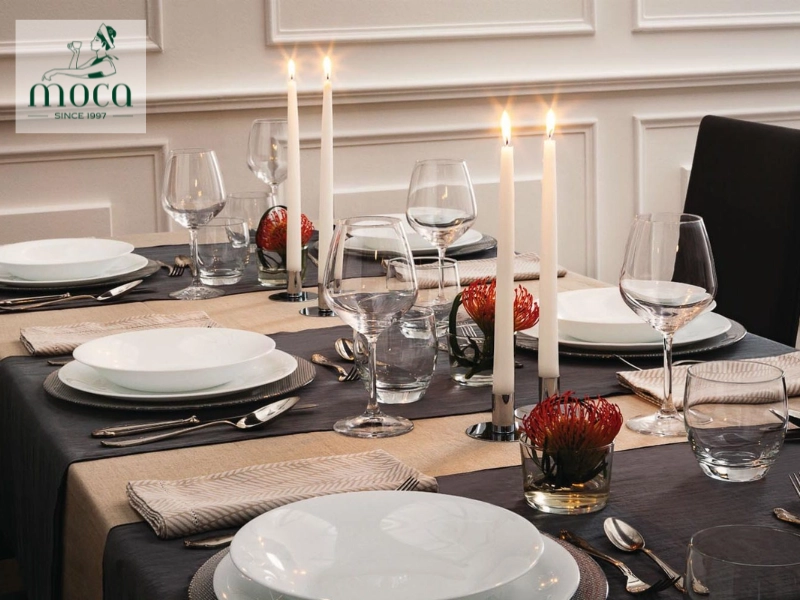
A perfect fine dining table setting: elegance in every detail, guiding the guest through a memorable culinary journey.
Learn more: Fine Dining Dish: Discover the Pinnacle of Culinary Art
2. The standard rules of fine dining table setting
Understanding how to set a fine dining table involves adhering to established conventions that ensure both elegance and practicality. These table setting etiquette guidelines are recognized internationally.
Placement of knives, forks, and spoons:
The fundamental rule for cutlery placement is "work from the outside in." Utensils are arranged in the order of their use, with those required for the first course placed furthest from the plate.
- Knives: All knives are placed to the right of the plate, with the cutting edge facing inward, towards the plate. This includes the dinner knife, fish knife, and any other specialized knives.
- Forks: Forks are placed to the left of the plate. This includes the dinner fork, salad fork, and fish fork. If an oyster fork is used, it is an exception and is placed to the right of the spoons.
- Spoons: Spoons are placed to the right of the knives. This includes the soup spoon and any dessert spoons that are not brought with the dessert course. If dessert utensils are placed at the beginning, the dessert spoon and fork are typically positioned horizontally above the main plate, with the spoon handle to the right and the fork handle to the left.
- Specialized Utensils: A fish knife has a unique shape, often with a wider blade and a notched tip, designed to help separate fish flesh from the bones. A salad fork is often smaller than the dinner fork.

Cutlery placement: knives (blades in) and spoons on the right, forks on the left—arranged from outside in for perfect fine dining.
Placement of glasses:
Glassware arrangement also follows a logical order, typically placed to the upper right of the dinner plate, above the knives.
- Water Glass: The water goblet is usually the largest glass and is placed directly above the knives.
- Wine Glasses: Wine glasses are set to the right of the water glass. If multiple wine glasses are used (e.g., for red and white wine), they are often arranged in a slight diagonal or triangular formation, in the order of their use. For example, the white wine glass (for earlier courses) would be closer to the hand than the red wine glass.
- Champagne Flute: If champagne or sparkling wine is served, the flute is typically placed to the right and slightly behind the wine glasses, or in a position that allows for easy pouring.
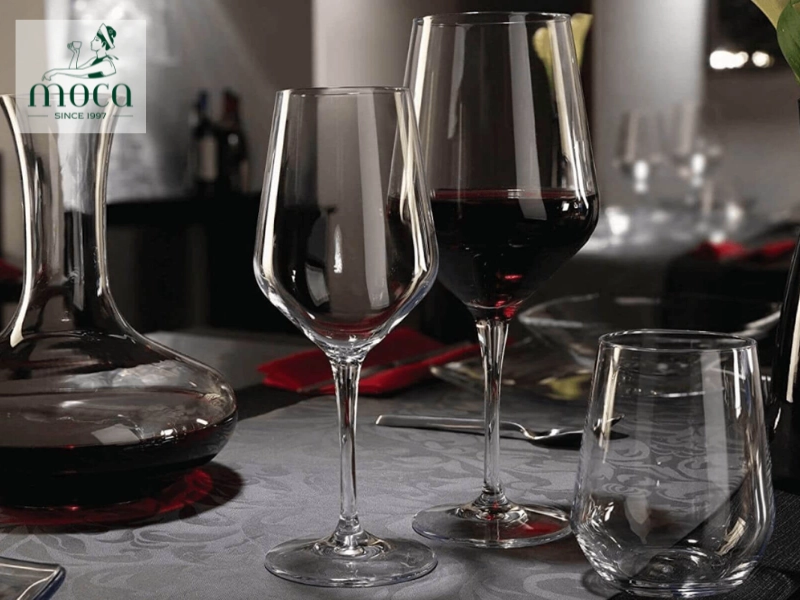
Glassware in perfect harmony: water goblet above knives, wine glasses arranged by order of service, and the champagne flute ready for celebration.
Placement of plates and bowls:
The dinnerware setup forms the centerpiece of the setting.
- Main course plate (or service plate/charger): A charger, or service plate, is a large decorative plate that remains on the table throughout the initial courses and is removed before the main course is served (or the main course plate is placed directly upon it). If no charger is used, the space is often left empty until the first course is served.
- Bread plate: The bread plate is a small plate placed to the upper left of the main plate, above the forks. A small butter knife is usually placed horizontally or diagonally across the bread plate, blade facing inward.
- Soup bowl: If soup is the first course, the soup bowl may be placed on top of the charger or main plate.
- Napkin use: The napkin can be artfully folded and placed in the center of the charger/plate, to the left of the forks, or within a wine glass. Upon being seated, the diner should place the napkin on their lap.

Center stage: the charger plate anchors the setting, with bread plate and butter knife to the left, soup bowl ready on top, and the napkin folded with elegance.
Other decorative items:
Table decorations contribute significantly to the ambiance of a fine dining table setting.
- Centerpieces: Flowers or other decorative centerpieces should be low enough not to obstruct conversation across the table.
- Candles: Candles can add warmth and intimacy but should be unscented so as not to interfere with the aroma of the food.
- Harmony and Refinement: The key is to achieve a harmonious and refined look. Decorations should complement the tableware and the overall dining room décor, not overwhelm it. Simplicity often equates to elegance.
- Table Setting Styles: Different styles can be adopted, from a very traditional and ornate formal dinner setup to a more minimalist and contemporary arrangement.
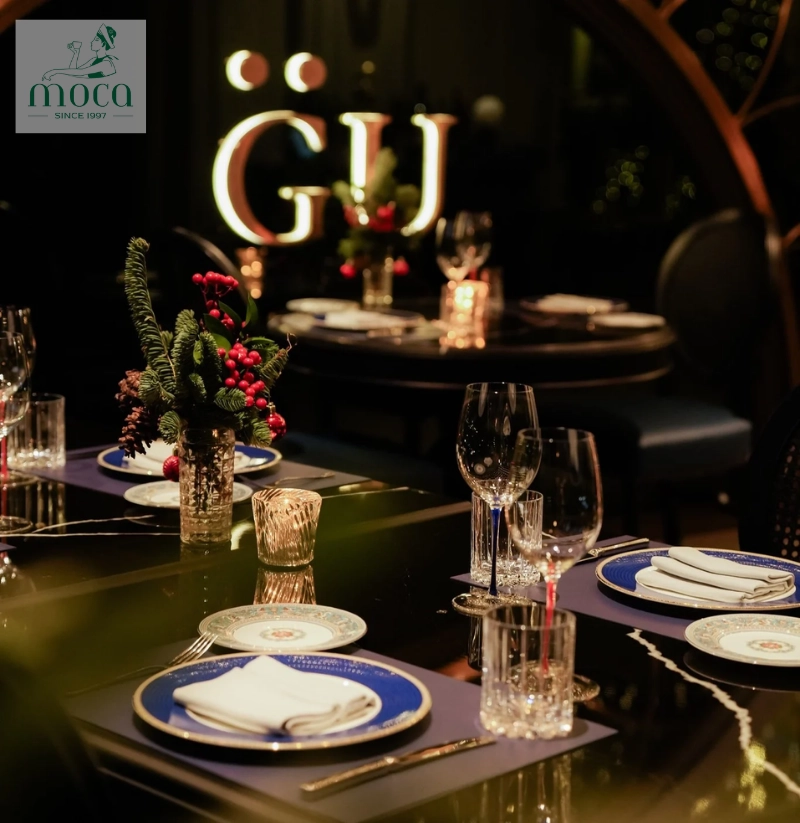
Elegance in simplicity: low floral centerpieces and unscented candles set a refined mood without overpowering the dining experience.
3. The meaning of items on a fine dining table
Each item in a fine dining table setting has a purpose and often a rich history, reflecting centuries of culinary and cultural evolution.
- Knives: Originally more dagger-like, table knives evolved to have rounded tips by the decree of King Louis XIV of France in the 17th century, purportedly to discourage violence at the dinner table. The dinner knife is the all-purpose knife. The fish knife, with its specific shape, emerged in the Victorian era when specialized utensils became fashionable, designed to delicately handle fish.
- Forks: Forks were adopted relatively late in European dining history, becoming common only by the 18th century. Earlier, diners primarily used knives and their fingers. The number of tines and the size of the fork vary depending on its intended use (e.g., a smaller salad fork, a robust dinner fork, a delicate dessert fork).
- Spoons: Spoons are among the oldest eating utensils. The soup spoon is typically larger and more rounded. Teaspoons and dessert spoons are smaller.
- Glasses: The shapes of wine glasses are specifically designed to enhance the aroma and flavor of different types of wine. A large bowl for red wine allows for aeration, while a narrower bowl for white wine helps maintain its cooler temperature and concentrate its more delicate aromas. The tall, slender shape of a champagne flute preserves carbonation and directs bubbles upward.
- Plates: The charger plate (from the Old French "chargeour," meaning a large platter) historically served to protect the table and tablecloth from spills and heat. The bread plate signifies the importance of bread as a staple accompaniment to meals in many cultures.
The evolution of these items is deeply intertwined with culinary history, etiquette, and even technological advancements in manufacturing. For example, the widespread availability of silver and later stainless steel significantly impacted the design and accessibility of cutlery. Different cultures also have variations; for instance, in some Asian fine dining table settings, chopsticks and ceramic spoons will be the primary utensils, arranged with similar precision.
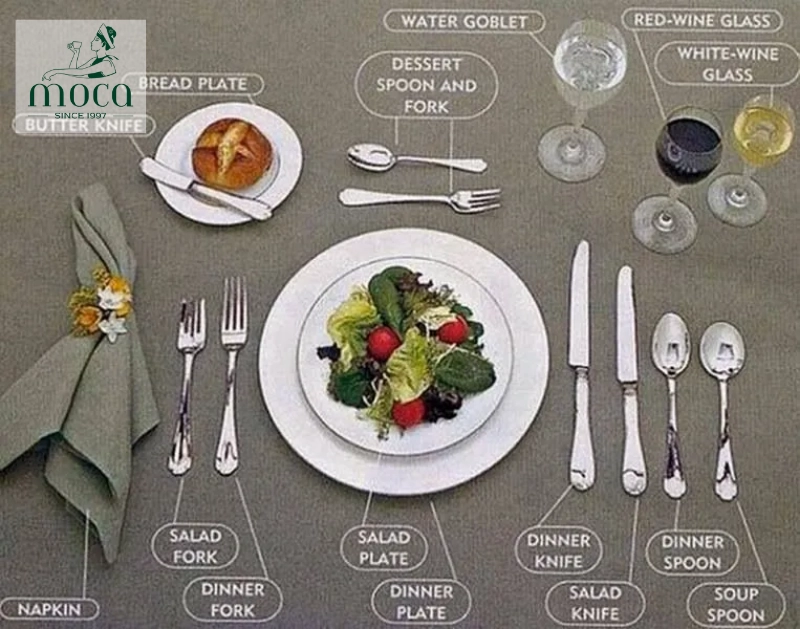
Every utensil tells a story — from the rounded knives inspired by history to glassware shaped to elevate each sip.
Learn more: Master Fine Dining Cooking Techniques: Elevate Your Culinary Skills
4. Popular fine dining table setting styles
While the fundamental rules of how to set a fine dining table provide a framework, various styles can be expressed within these guidelines.
- Classic style (Traditional): This style emphasizes timeless elegance and formality. It often features fine china with traditional patterns (e.g., floral or gold-rimmed), polished silverware (often sterling silver or silver plate), crystal glassware, and linen napkins and tablecloths. Centerpieces are typically classic floral arrangements. The overall feel is one of opulence and established tradition.
- Modern style (Minimalist): This approach favors clean lines, simplicity, and functionality. Tableware might consist of unadorned white or monochromatic plates, sleek, contemporary cutlery, and simple, elegant glassware. Decoration is often sparse, perhaps a single sculptural element or a very simple floral arrangement. The focus is on understated sophistication and allowing the food to be the star.
- Seasonal style: This style incorporates elements that reflect the time of year or a specific celebration. For example, a Christmas table decoration might feature rich reds and greens, pinecones, holly, and themed centerpieces. An autumn setting might use warmer earth tones, gourds, and fall foliage. This allows for creativity and a thematic connection to the occasion.
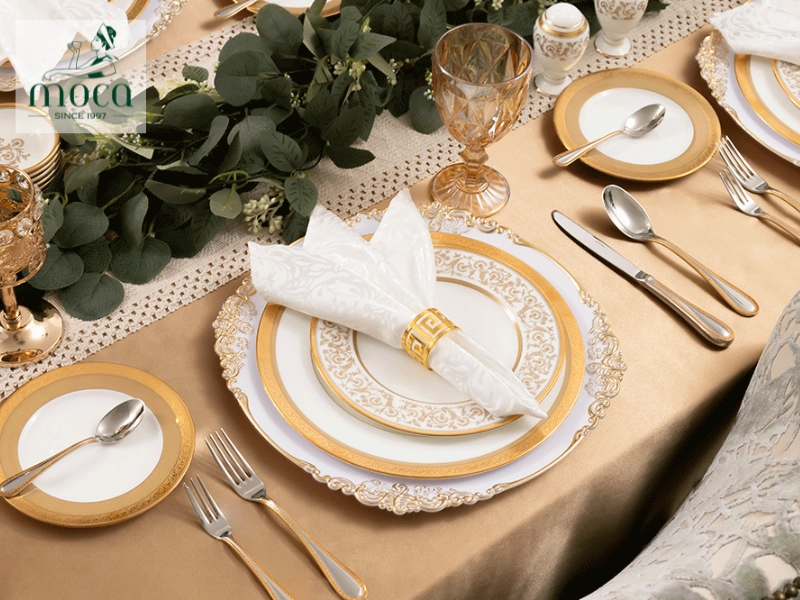
Fine dining table settings come in many styles — from classic elegance to modern minimalism and seasonal charm.
5. Fine dining table setting at Moca Dining
At Moca Dining, we believe that the fine dining table setting is an integral part of the prelude to an exceptional culinary experience. Our ambiance is one of understated elegance and contemporary sophistication. The table setting style at Moca Dining is carefully curated to reflect this, blending modern aesthetics with timeless principles of refinement.
We utilize high-quality, bespoke tableware that complements the artistry of our cuisine. Crisp linens, polished glassware that enhances the nuances of our curated wine list, and thoughtfully selected cutlery are standard. The lighting is designed to create a warm and inviting atmosphere, while table decorations are elegant yet unobtrusive, ensuring they enhance rather than distract from the dining experience and conversation. The sophistication lies in the attention to every detail, from the precise alignment of each element to the quality of the materials used. Our aim is to create a unique table setting that feels both luxurious and welcoming, setting the stage for the culinary journey that awaits. We are always delighted to receive customer reviews and feedback, many of which comment favorably on the serene and polished ambiance created by our dining room setup.
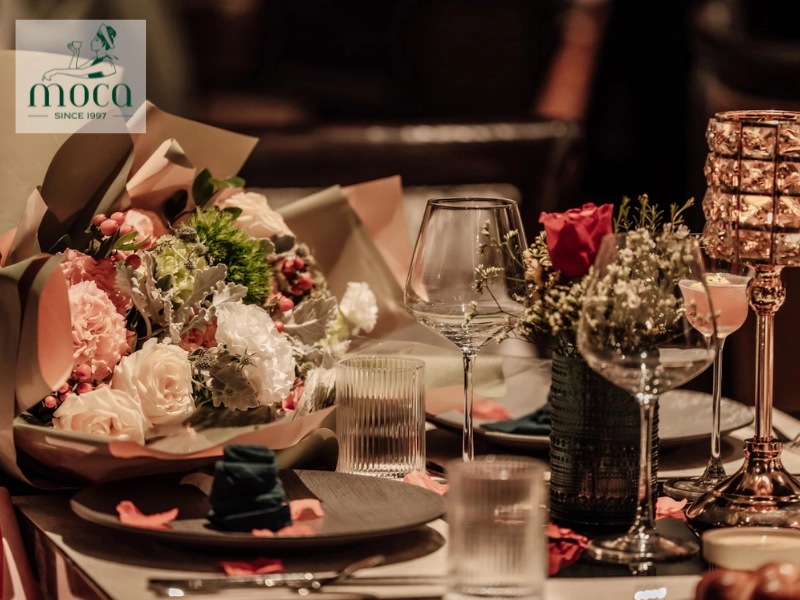
Moca Dining’s table setting: where modern elegance meets timeless refinement, setting the perfect stage for your culinary journey.
The fine dining table setting is more than just an arrangement—it’s a graceful expression of respect for the food, the guest, and the art of dining. Each element, from the choice of utensils to the harmonious design, carries historical significance and contributes to an elegant, memorable experience. At Moca Dining, we carefully craft every detail of your visit, and our table settings reflect this dedication. We invite you to immerse yourself in a refined ambiance where the silent language of elegance enhances your culinary journey.








